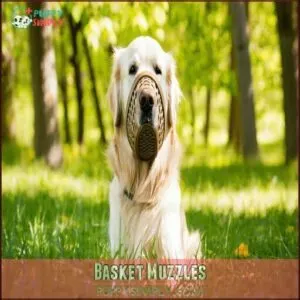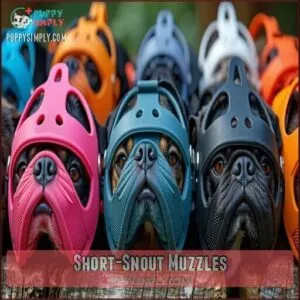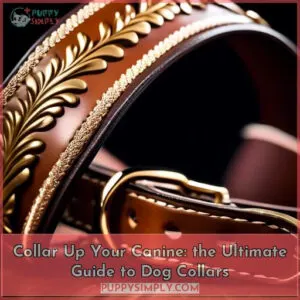This site is supported by our readers. We may earn a commission, at no cost to you, if you purchase through links.
 When choosing the best dog muzzles, you’ll want to prioritize comfort, breathability, and proper fit.
When choosing the best dog muzzles, you’ll want to prioritize comfort, breathability, and proper fit.
Basket muzzles like the Baskerville Ultra allow your pup to pant and drink while preventing biting.
For short medical procedures, soft sleeve muzzles work well—just like putting a snug sock on your dog’s snout.
Match the muzzle type to your specific need: training, grooming, vet visits, or walks where your four-legged vacuum cleaner might scavenge.
Remember, a muzzle isn’t a muzzle-shaped punishment but a safety tool that, when introduced properly, your dog won’t mind wearing.
The right introduction technique makes all the difference, ensuring a positive experience for your dog.
Table Of Contents
- Key Takeaways
- Choosing Best Dog Muzzles
- Dog Muzzle Types
- Reasons for Using Muzzles
- Top 16 Best Dog Muzzles
- Baskerville Ultra Dog Muzzle
- 2. Pitbull Dog Muzzle Breathable Metal Basket
- 3. Orange XS Paxton Adjustable Pet Muzzle
- 4. Extra Small Dog Anti Bite Muzzle
- 5. Breathable Dog Muzzle for Large Breeds
- 6. Soft Mesh Dog Muzzle Adjustable Straps
- 7. Breathable Dog Muzzle for Small Breeds
- 8. Breathable Dog Muzzle Large Black
- 9. Jafco Clear 3 High Definition Lens
- 10. Birdwell Plastic Dog Muzzle Medium Blue
- 11. Mayerzon Breathable Dog Muzzle
- 12. Bronzedog Adjustable Dog Muzzle Breathable Durable
- Secure Leather Dog Muzzle Large Breed
- 14. Mayerzon Dog Muzzle Soft Breathable Adjustable
- 15. Barkless Dog Muzzle Soft Silicone Safe
- 16. Soft Dog Muzzle Gentle Training Aid
- Muzzle Safety Precautions
- Benefits of Using Muzzles
- Muzzle Training Tips
- Common Muzzle Misconceptions
- When to Use Muzzles
- Frequently Asked Questions (FAQs)
- What type of muzzle is best for a dog?
- Do vets recommend muzzles?
- What are the most comfortable muzzles for dogs?
- What can I use instead of a dog muzzle?
- Should I put a muzzle on my aggressive dog?
- What is the most dog friendly muzzle?
- What type of dog muzzle is best?
- What type of muzzle is best for an aggressive dog?
- What to use instead of a muzzle?
- What is the best muzzle to prevent bites?
- Conclusion
Key Takeaways
- When choosing a dog muzzle, you’ll want to prioritize breathability, proper fit, and comfort – basket muzzles like the Baskerville Ultra allow your dog to pant, drink, and take treats while preventing biting.
- You should match the muzzle type to your specific need – basket muzzles for longer wear, soft sleeve muzzles for short medical procedures, and specialized options for short-snouted breeds.
- Proper introduction and training is essential – use positive reinforcement techniques and gradual desensitization to help your dog accept the muzzle as a safety tool rather than a punishment.
- Remember that muzzles serve many purposes beyond aggression control – they’re valuable for vet visits, grooming sessions, preventing scavenging, and ensuring safety in public settings while you work on underlying behavioral issues.
Choosing Best Dog Muzzles
When choosing the best dog muzzle, focus on breathability, sturdy materials, and adjustable features to guarantee your dog’s comfort and safety.
A well-fitted muzzle isn’t just practical—it keeps your furry friend happy and secure, even in tricky situations.
Importance of Breathability
Breathable muzzles are essential for your dog’s comfort and safety.
Good ventilation designs let dogs pant naturally, preventing overheating risks, especially in warm weather.
Proper dog muzzle breathability addresses breed differences, ensuring brachycephalic dogs don’t face breathing concerns.
Always prioritize panting ability, as restricted airflow can stress your pup.
Muzzles are useful to prevent bites, especially in emergencies, so breathability is key.
Choose materials promoting airflow to keep them happy and healthy.
Material Options
Choosing the right muzzle material makes all the difference.
Leather options offer long-lasting comfort, while biothane benefits include flexibility and durability.
Mesh muzzles prioritize breathability, great for everyday use.
For lightweight convenience, nylon muzzles and plastic safety designs work well, but wear short-term.
Rubber durability shines in rugged situations.
Exploring various muzzle materials can help owners make informed choices.
Matching muzzle types to your dog’s needs guarantees the best fit.
Adjustable Features
Adjustable straps are a game-changer, letting you tweak the fit for your dog’s comfort and safety.
Look for durable strap materials and buckle types that won’t slip.
Fit customization guarantees a snug yet breathable design, while expandable sizes cater to growing pups.
Proper dog muzzle adjustability avoids pinching or chafing, making it easy to nail the perfect dog muzzle fit every time with proper dog muzzle adjustability.
Dog Muzzle Types
Choosing the right type of muzzle depends on your dog’s needs, comfort, and safety.
From basket muzzles to soft sleeves and short-snout designs, each type offers unique benefits for various situations, and choosing the right one is crucial.
Basket Muzzles
Basket muzzles are a top choice for safety and comfort.
They let your dog pant, drink, and enjoy treats while ensuring a secure fit.
Made from durable materials like rubber or metal, they accommodate various breeds and sizes.
Many owners find it convenient to shop for options online.
Perfect for longer wear, these dog muzzle types balance functionality with comfort, making them ideal for training or managing behavior.
Soft Sleeve Muzzles
Soft sleeve muzzles are perfect for short-term use, like vet visits or grooming.
These lightweight options prioritize dog comfort but aren’t ideal for prolonged wear. With proper sizing, they fit snugly, preventing biting without causing distress.
Many retailers offer various soft models for different breeds.
- Material limitations: Often nylon or mesh.
- Cleaning methods: Wash delicate fabrics regularly.
- Best for calm dogs: Requires monitoring.
- Affordable: Great budget-friendly muzzle for dogs.
Short-Snout Muzzles
Short-snout muzzles are your go-to for breeds like pugs or bulldogs.
These designs tackle ventilation challenges while ensuring a comfortable dog muzzle fit. Look for soft, safe materials like silicone or biothane, shaped for short-nosed dogs’ unique features.
Custom solutions and breed-specific fit make these the best dog muzzle options, balancing safety with a snug, secure hold.
When selecting a muzzle, remember to keep in mind breathability and panting, considering breed-specific needs and ensuring a comfortable dog muzzle fit.
Reasons for Using Muzzles
Using a muzzle can help prevent biting, keep everyone safe during vet visits, or guarantee a smoother grooming session.
It’s a practical tool for managing challenging situations while prioritizing your dog’s well-being.
Aggressive Behavior Prevention
When managing dog aggression, muzzles are valuable tools for bite prevention and safety.
They allow safe socialization with other dogs while protecting everyone involved. Early socialization and proper training techniques, paired with professional help, guarantee success.
Consider environmental management and breed predispositions when addressing aggressive behavior. A well-fitted muzzle supports dog aggression management without discomfort, promoting calm interactions.
Addressing a dog’s behavior can be improved using positive reinforcement techniques, which is a key aspect of dog aggression management and ensures safe socialization.
Safety During Medical Treatment
Muzzles can be lifesavers during stressful vet visits.
They keep everyone safe, minimize anesthesia risks, and prevent bites when a dog feels cornered.
For post-op protection or injury prevention, a well-fitted dog muzzle guarantees proper care without fear of harm.
Whether it’s medication administration or routine checks, veterinary safety depends on making your pet feel secure during medical treatment, which is crucial for proper care.
Assistance in Grooming Sessions
Grooming sessions can be stressful, especially for anxious pups. A well-fitted dog muzzle guarantees safety and calmness without compromising comfort.
Proper muzzle acclimation and positive reinforcement make a world of difference.
- Protects groomers from accidental nips.
- Ideal for breed-specific grooming challenges.
- Encourages smoother dog grooming experiences.
- Promotes veterinary safety during medical treatments.
- Regular muzzle maintenance enhances durability and hygiene.
Top 16 Best Dog Muzzles
Finding the right muzzle for your dog guarantees their comfort, safety, and proper behavior in various situations.
We’ve narrowed down the top 16 options so you can choose a reliable, well-fitted muzzle with ease.
Baskerville Ultra Dog Muzzle
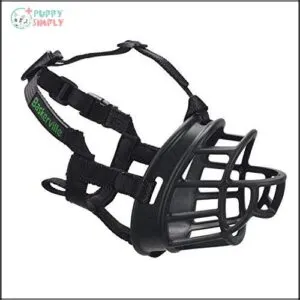
The Baskerville Ultra Dog Muzzle is like a protective shield for your pup’s snout, combining safety and comfort effortlessly.
Made from durable thermoplastic rubber, it’s both strong and flexible, ensuring a secure yet comfy fit.
Your dog can pant, drink, and even enjoy treats while wearing it, thanks to its clever basket-style design.
Adjustable straps and a heat-moldable feature make it easy to customize, ideal for vet visits, training, and everyday walks, it’s a trusted pick for peace of mind.
Best For: Dog owners who want a safe, comfortable, and customizable muzzle for managing reactive or nervous dogs during walks, training, or vet visits.
- Allows dogs to pant, drink, and take treats.
- Heat-moldable for a tailored, secure fit.
- Lightweight, durable, and escape-resistant design.
- Can require patience for proper fitting and shaping.
- May not suit dogs resistant to wearing muzzles initially.
- High demand may lead to 1-2 week wait times.
2. Pitbull Dog Muzzle Breathable Metal Basket
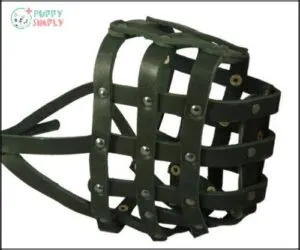
For large breeds like Pitbulls, the BRONZEDOG Metal Basket Muzzle is a game-changer.
Its durable metal mesh guarantees breathability while allowing your dog to pant, drink, and take treats, making it ideal for walks and vet visits.
Adjustable leather straps guarantee a snug fit, though measuring your dog’s snout is key for comfort.
This lightweight muzzle keeps safety in check without adding stress to your furry friend, and it’s expected to be paw-fect if you avoid cutting corners on sizing to confirm it’s as comfortable as expected!
Best For: Large breed dogs like Pitbulls and Amstaffs that need a secure, breathable, and comfortable muzzle for walking, vet visits, and training.
- Durable metal mesh allows panting, drinking, and taking treats.
- Adjustable leather straps ensure a secure and comfortable fit.
- Breathable design reduces stress during extended wear.
- Limited flexibility may not accommodate unique snout shapes.
- Incorrect sizing can cause discomfort or require returns.
- Leather straps may get damaged if extra holes are added poorly.
3. Orange XS Paxton Adjustable Pet Muzzle
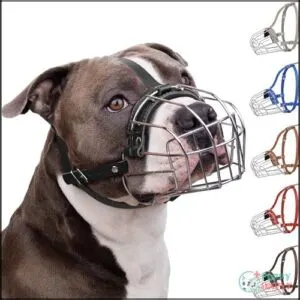
Looking for a no-fuss solution for your small dog? The Orange XS Paxton Adjustable Pet Muzzle is a practical choice.
Its lightweight, breathable mesh keeps your pup comfy while durable nylon guarantees safety. Customizing the fit is simple with adjustable straps, and there’s plenty of room for panting and drinking.
Perfect for vet visits, grooming, or curbing naughty chewing habits, it’s also water-resistant for easy cleaning.
However, note it’s best for smaller breeds and may not handle heavy chewers or extreme force.
Best For: Small dog breeds needing a comfortable, adjustable muzzle for vet visits, grooming, or preventing chewing.
- Lightweight, breathable mesh for comfort.
- Adjustable straps for a secure, custom fit.
- Water-resistant and easy to clean.
- Limited to small dog breeds.
- May not withstand heavy chewing or extreme force.
- Snap buckles can wear out over time.
4. Extra Small Dog Anti Bite Muzzle
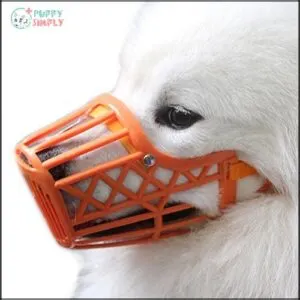
The Extra Small Dog Anti Bite Muzzle is a clever solution for pint-sized pups who might bark, bite, or chew excessively.
Made from breathable soft mesh, it guarantees comfort and airflow while allowing your dog to drink water without removal.
Its reflective, adjustable straps keep it securely in place during playful or active moments, making it perfect for breeds like Chihuahuas.
This muzzle is ideal for training, vet visits, or socialization, and just requires close monitoring in warmer conditions to prevent overheating or discomfort.
Best For: Small dog breeds prone to excessive barking, biting, or chewing, especially during training, vet visits, or socialization.
- Breathable soft mesh ensures comfort and allows airflow.
- Reflective, adjustable straps provide a secure fit.
- Allows dogs to drink water without removing the muzzle.
- May restrict airflow in hotter conditions.
- Not resistant to aggressive chewing.
- Requires close supervision to prevent discomfort or overheating.
5. Breathable Dog Muzzle for Large Breeds
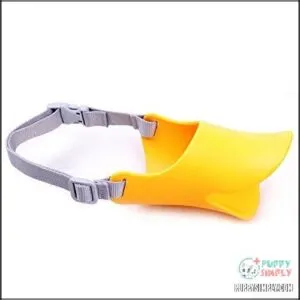
If you’ve got a big dog who’s strong-willed, a breathable muzzle can be a lifesaver for managing behavior safely.
Designed with large breeds in mind, these muzzles let your dog pant, drink, and even bark softly while keeping everyone safe.
Adjustable straps guarantee a snug fit—no slipping or discomfort here, and they are made of durable materials like rubber or silicone that can handle your dog’s strength.
Look for these features when selecting a muzzle, as it’s perfect for vet visits, public outings, or preventing chewing, making it practical and comfortable for your furry friend.
Best For: Large breed dog owners looking for a safe and breathable solution to manage unwanted behaviors like chewing, biting, or aggression.
- Provides ample airflow, allowing dogs to pant, drink, and even bark softly.
- Adjustable straps ensure a snug and secure fit for large breeds.
- Made from durable materials like silicone or rubber to withstand strong dogs.
- May not fully prevent ground-level eating due to the design.
- Requires proper fitting to avoid discomfort or slipping.
- Not suitable for long-term or continuous wear.
6. Soft Mesh Dog Muzzle Adjustable Straps

Soft Mesh Dog Muzzle with Adjustable Straps is perfect for keeping your dog safe without sacrificing comfort.
The breathable, gentle mesh design allows panting and drinking while preventing biting, chewing, or licking.
Secure, adjustable straps guarantee a snug fit for almost any breed, making it great for energetic pups or unpredictable outings.
Available in multiple sizes and colors, it’s also durable enough to withstand daily wear and tear.
Whether at the vet or on walks, this muzzle offers functionality and peace of mind.
Best For: Energetic dogs or those needing safe, comfortable control during outings or vet visits.
- Breathable mesh design allows panting and drinking.
- Adjustable straps ensure a secure and custom fit.
- Durable and resistant to daily wear and tear.
- May not fit all dog breeds perfectly.
- Limited to specific sizes and colors available.
- Could take time for dogs to adjust to wearing it.
7. Breathable Dog Muzzle for Small Breeds
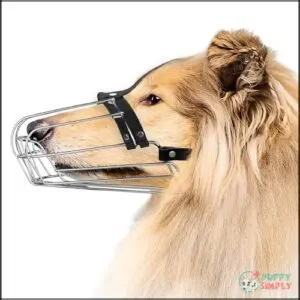
For small dog breeds, the breathable dog muzzle offers a perfect blend of comfort and control.
Crafted from soft silicone, it contours gently around your dog’s snout, allowing easy breathing, panting, and safe behavior. The lightweight design guarantees your pup stays comfortable, even during longer wear.
Reflective and adjustable straps add safety and a snug fit, making it great for walks or vet visits.
Just remember to leave enough room for one finger when measuring for the right fit—it makes all the difference!
Best For: Small dog breeds needing a comfortable and breathable muzzle for safe behavior during walks, vet visits, or other activities.
- Soft silicone design contours to the snout for comfort.
- Reflective and adjustable straps ensure safety and a snug fit.
- Allows easy breathing, panting, and regular behavior.
- Requires precise measurement to ensure a proper fit.
- May not be suitable for breeds with very short snouts.
- Lightweight design might lack durability for highly active dogs.
8. Breathable Dog Muzzle Large Black
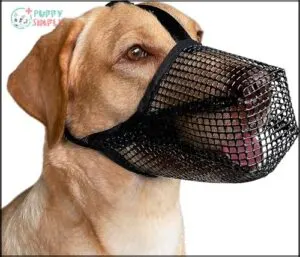
The Breathable Dog Muzzle Large Black is perfect for bigger breeds needing secure, comfortable restraint.
Its lightweight mesh design guarantees airflow, so your dog can breathe and pant freely. Adjustable straps provide a snug fit without causing discomfort, making it ideal for walks, training, or vet visits.
Designed for safety, it prevents biting or scavenging while letting your dog stay hydrated. With its durable build and sleek black color, this muzzle is both practical and stylish—a reliable choice for active, large-breed dogs, offering secure and comfortable restraint.
Best For: Large-breed dogs requiring a breathable, secure muzzle for activities like walking, training, and vet visits.
- Lightweight mesh design ensures proper airflow for breathing and panting.
- Adjustable straps provide a snug, comfortable fit for active dogs.
- Prevents biting and scavenging while allowing drinking and hydration.
- Not suitable for short-snout breeds like English Bulldogs.
- Reports of durability issues after extended use.
- Must supervise dogs during wear; not recommended for prolonged unsupervised use.
9. Jafco Clear 3 High Definition Lens
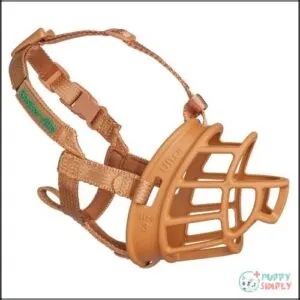
Designed for safety and convenience, the Jafco Clear 3 High Definition Lens muzzle offers a smart solution for managing reactive dogs.
Its transparent Thermo Plastic Rubber allows panting, drinking, and treat-giving, ensuring comfort during wear.
You’ll appreciate the customizable fit, which takes just 15-20 minutes to adjust for your dog’s snout.
The padded straps are durable, locking securely in place for added security. Though it’s not ideal for vet visits, this muzzle excels in training and preventing aggression, making it a reliable choice.
Best For: Dog owners who need a safe, humane, and customizable muzzle for training or managing reactive dogs.
- Allows dogs to pant, drink, and receive treats for comfort and training.
- Customizable fit with durable, padded straps for secure wear.
- Recommended by trainers and veterinarians for its effectiveness and reliability.
- Not suitable for vet visits or situations requiring total bite prevention.
- Straps require careful adjustment for proper fit.
- Customization process takes 15-20 minutes, which may not suit all users.
10. Birdwell Plastic Dog Muzzle Medium Blue

If you’re managing a medium-sized dog with a knack for chewing or barking, the Birdwell Plastic Dog Muzzle Medium Blue has you covered.
Made from durable, lightweight plastic, it guarantees comfort without sacrificing safety, while adjustable straps create a snug, customizable fit.
Its vibrant blue design isn’t just stylish but practical for visibility, and ventilation holes keep airflow steady, especially during warm days.
Ideal for grooming or vet visits, this muzzle emphasizes ease of use, making responsible pet ownership straightforward and hassle-free.
Best For: Medium-sized dogs with long, slim noses prone to biting, chewing, or barking, especially during training, grooming, or vet visits.
- Durable, lightweight plastic with adjustable straps for a secure fit.
- Ventilation holes ensure proper airflow for the dog’s comfort.
- Open basket design allows panting and drinking freely.
- Not suitable for short, wide-nosed breeds like Bulldogs or Pugs.
- Requires proper snout measurements to ensure accurate fit.
- Limited availability, with stock varying by retailer.
11. Mayerzon Breathable Dog Muzzle

The Mayerzon Breathable Dog Muzzle is a practical option for safety-conscious dog owners.
With its soft yet durable rubber material and mesh design, it guarantees maximum ventilation, letting your dog pant, drink, and stay comfy.
The adjustable nylon strap provides a secure fit, and it’s gentle on your dog’s skin, making it great for long walks or training sessions.
Ideal for preventing chewing, nipping, or scavenging, this muzzle keeps control manageable.
It’s lightweight, easy to clean, and designed to last.
Best For: Owners of friendly dogs needing a comfortable, breathable muzzle for walks, training, or grooming.
- Not suitable for dogs with high bite risk or extreme reactivity.
- Open basket design may allow some dogs to remove it with paws.
- May require trial and error for proper sizing and fit.
- Lightweight and breathable with a mesh and rubber design for comfort.
- Adjustable straps ensure a secure and customizable fit.
- Allows dogs to pant, drink, and receive treats easily.
12. Bronzedog Adjustable Dog Muzzle Breathable Durable
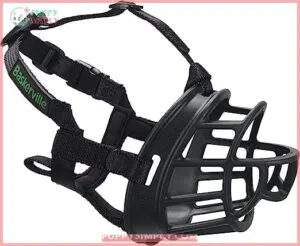
In the context of controlling powerful dogs, the Bronzedog Adjustable Dog Muzzle is a game-changer.
Its metal wire basket design is tough but lightweight, offering durability without sacrificing comfort. The genuine leather straps provide a secure fit, and adjustable buckles guarantee it stays in place, even during spirited walks.
Dogs can breathe, drink, and pant freely, making it perfect for everyday use. This muzzle stands up to wear and tear, proving it’s built to last—a no-brainer for large or energetic breeds, as it is a game-changer.
Best For: Large or energetic breeds requiring a secure, durable, and breathable muzzle for training or everyday use.
- Durable metal wire basket and leather straps ensure long-lasting use.
- Allows dogs to breathe, drink, and pant freely for comfort and safety.
- Provides a secure fit with adjustable and sturdy buckles.
- Not suitable for small dogs or those with uniquely shaped snouts.
- Lacks customization features such as heat shaping for a tailored fit.
- May require additional effort to ensure a comfortable fit for extended wear.
Secure Leather Dog Muzzle Large Breed
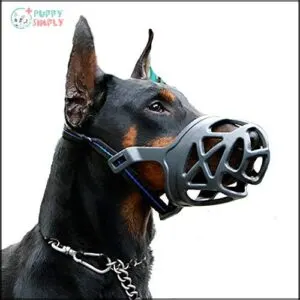
A blend of strength and comfort, the Secure Leather Dog Muzzle is perfect for large breeds like German Shepherds or Dobermans.
Crafted from durable, non-toxic leather, it’s sturdy yet gentle on your dog’s skin. The ventilated design guarantees easy panting and breathing, while adjustable straps promise a snug fit.
Ideal for training, vet visits, or preventing biting, it balances control with comfort. If you need dependable protection that doesn’t compromise your dog’s ease, this muzzle’s a reliable, stylish option for safety.
Best For: Large breed dog owners seeking a durable, adjustable muzzle for training, vet visits, and preventing unwanted behaviors.
- Durable leather construction ensures longevity and strength.
- Ventilated design allows for easy breathing and panting.
- Adjustable straps provide a secure and customized fit.
- Not suitable for dogs with short or pushed-in muzzles.
- May require re-adjustments for optimal comfort.
- Less flexible compared to rubber muzzles for rough play.
14. Mayerzon Dog Muzzle Soft Breathable Adjustable
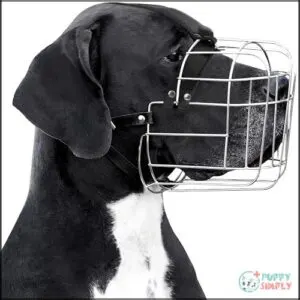
The Mayerzon Dog Muzzle offers a great balance of comfort and safety, making it a solid option for training or outings.
Crafted from lightweight, breathable materials with soft padding, it guarantees your dog can pant and drink while staying secure.
Adjustable straps provide a customizable fit, reducing slipping during wear, and it’s a good pick for dogs that need gentle control without compromising their movement.
Best used for friendly dogs during groomer visits or public use, it isn’t ideal for high bite-risk situations.
Best For: Friendly dogs needing gentle control for outings, grooming, or public transport.
- Lightweight, breathable materials with soft padding for comfort.
- Adjustable straps for a customizable, secure fit.
- Allows panting and drinking while preventing biting and scavenging.
- Not suitable for high bite-risk dogs due to soft material.
- Sizing may require adjustments for a proper fit.
- Less durable for dogs with aggressive chewing tendencies.
15. Barkless Dog Muzzle Soft Silicone Safe
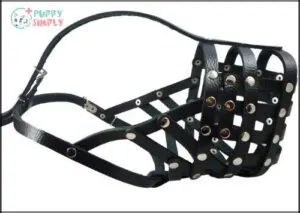
The Barkless Dog Muzzle shines with its soft silicone build, combining comfort with safety.
Its lightweight design and neoprene-lined bottom guarantee a snug fit, protecting your dog’s skin.
Adjustable, reflective straps add visibility and security, while the safety loop connects to the collar for peace of mind.
This muzzle allows panting and drinking but isn’t chew-proof, making it best for non-aggressive dogs, and is suitable for everyday safety.
Perfect for training or conditioning, it’s breathable, sturdy, and a solid pick.
Best For: Non-aggressive dogs needing a lightweight, breathable muzzle for training or everyday safety.
- Soft silicone and neoprene lining ensure comfort.
- Allows panting and drinking for ease of use.
- Adjustable and reflective straps add security and visibility.
- Not chew-proof and unsuitable for determined biters.
- Limited effectiveness for high bite-risk dogs.
- Straps and safety features may require regular adjustments.
16. Soft Dog Muzzle Gentle Training Aid
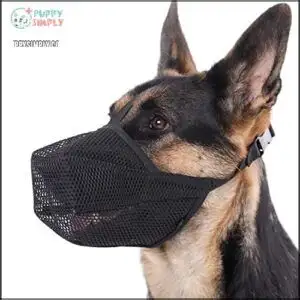
Designed for gentleness, the Soft Dog Muzzle Training Aid offers a humane approach to curbing unwanted behaviors.
It prevents biting and excessive chewing while still allowing your dog to breathe, pant, and drink comfortably.
The breathable mesh fabric construction guarantees adequate airflow, with adjustable straps and nose padding for a secure fit without discomfort.
This muzzle works best as a short-term solution during training sessions, vet visits, or grooming appointments.
It’s not recommended for extended wear or hot days, as it may restrict cooling, making it perfect for temporary use when you need a simple, effective training tool.
Best For: Pet owners looking for a temporary and humane solution to manage their dog’s biting or chewing behaviors during short activities like training, grooming, or vet visits.
- Not suitable for short-snouted dogs or bite-risk animals.
- Limited durability in areas accessible to chewing.
- Unsuitable for prolonged use or hot weather due to overheating risks.
- Soft, breathable material allows comfortable breathing, panting, and drinking.
- Adjustable design ensures a secure fit for various breeds.
- Effective for managing undesirable habits without causing distress.
Muzzle Safety Precautions
You’ll need to monitor your dog closely when they’re wearing a muzzle, ensuring proper fit and checking regularly for signs of discomfort or overheating.
Proper muzzle safety isn’t just about preventing bites—it’s about keeping your furry friend comfortable while maintaining everyone’s safety.
Proper Fit and Size
Now that you’ve seen our top muzzle picks, let’s talk fit—it’s like finding the perfect pair of shoes for your pup’s snout.
Proper sizing requires measuring snout length (about ½" under eyes to ½" past nose end) and the diameter around the widest part of the mouth.
Your dog’s muzzle should allow full panting without being too tall. Remember that the muzzle should allow a regular pant.
You’ll know you’ve nailed the fit when it sits ½" away from the eyes and you can slip two fingers between the muzzle and snout.
Monitoring During Use
Never leave your dog unattended while wearing a muzzle. Regular checks during use help identify fit issues or signs of discomfort.
Watch for behavioral cues like excessive pawing, rapid breathing, or distress signals. Implement short "muzzle duration" periods initially, gradually increasing as your dog adjusts.
Keep emergency removal tools handy, especially in high-stress situations. Remember, proper dog muzzle monitoring prevents potential injuries and guarantees your furry friend remains comfortable and safe.
Avoiding Overheating
While watching your muzzled dog, pay close attention to signs of overheating. Dogs cool themselves by panting, so choose muzzle materials that allow this natural process.
Basket designs provide better hydration access than soft sleeve types.
Keep muzzle sessions to limited durations, especially for flat-faced breeds with breed sensitivity. Take regular shade breaks during warm weather. Remember: a dog that can’t pant properly can quickly overheat—your vigilance matters.
Benefits of Using Muzzles
You’ll find that proper muzzles protect both your furry friend and others around them, offering security during stressful situations like vet visits or crowded parks.
They’re also invaluable training tools that help manage unwanted behaviors such as excessive chewing or scavenging, giving you peace of mind while your dog learns better habits.
Preventing Biting and Chewing
Muzzles provide an effective barrier against destructive chewing and biting prevention. They’re essential tools for dogs with bite inhibition issues or those prone to consuming dangerous items.
Here are four key benefits of using muzzles for chewing deterrents:
- Prevents injury to people and other animals during stressful situations
- Protects your belongings from destructive chewing behaviors
- Serves as a temporary management tool while implementing training solutions
- Offers peace of mind when introducing dogs to new environments
Using muzzles can be particularly beneficial as they offer a temporary management tool, allowing for the implementation of training solutions to address the root cause of the behavior.
Ensuring Safety in Public Settings
Public safety brings peace of mind when you’re out with your dog.
Using a muzzle in crowded areas guarantees dog bite prevention and demonstrates proper muzzle etiquette.
You’ll comply with breed-specific legal requirements while allowing your pup to enjoy socialization.
For dog walks or public transport, a well-fitted muzzle reduces public liability concerns and provides crowd control in unpredictable situations.
It’s simply responsible ownership that keeps everyone comfortable, ensuring public safety through considerate actions.
Managing Aggressive Behavior
In the face of dog aggression, proper muzzle introduction can be your saving grace. You’ll gain control while working on behavior modification for your furry friend.
- Identify triggers that spark your dog’s aggressive reactions
- Choose appropriate muzzles based on breed predisposition and specific needs
- Implement consistent training alongside professional help
- Combine muzzle use with early socialization techniques for long-term improvement
Muzzles aren’t just tools—they’re stepping stones toward creating safer interactions for everyone involved, which is crucial for long-term improvement.
Muzzle Training Tips
You’ll need to train your dog to accept a muzzle properly before using it in stressful situations, just as you wouldn’t expect a child to wear glasses without some adjustment time.
Proper muzzle training involves gradual introduction with plenty of treats and positive reinforcement, making the experience pleasant rather than punishing for your four-legged friend, which is crucial for a successful and stress-free interaction.
Introducing The Muzzle
The first step in dog muzzle training requires patience and a gentle approach.
Let your pup see and sniff the muzzle before attempting placement. Keep initial sessions brief—just 1-2 minutes maximum.
For hesitant dogs, try placing the muzzle on the floor with treats leading to it. Once they’re comfortable, progress to holding it near them, using a marker word to signal rewards.
Positive Reinforcement
Now that you’ve introduced the muzzle to your dog, it’s time to create positive associations. Pair the muzzle with rewards your dog absolutely loves to build happy connections.
Here’s how to use positive reinforcement effectively:
- Offer high-value treats when your dog voluntarily approaches the muzzle
- Use clicker training to mark the exact moment of desired behavior
- Add lickable treats for extra motivation during muzzle acceptance
- Reward calm behavior while gradually increasing wear time to achieve successful training.
Gradual Desensitization
Now that your dog has embraced positive reinforcement with the muzzle, it’s time to build lasting comfort through gradual desensitization.
Practice in various environments to normalize muzzle wearing—don’t just save it for vet visits.
Keep sessions short with plenty of rewards for calmness. Incorporate breaks during training and slowly increase wear time while ensuring your pup has access to water.
Pair muzzle use with fun activities to create positive associations.
Common Muzzle Misconceptions
You’ll find that many common beliefs about dog muzzles aren’t based on facts, including the myth that they’re only for aggressive dogs or that they’re uncomfortable for your pet.
Properly fitted muzzles actually allow dogs to breathe, pant, and even drink water while providing necessary safety in specific situations, which makes them a useful tool for various scenarios.
Muzzles and Aggression
A common misconception places muzzles exclusively on aggressive dogs.
While they’re helpful for dog biting prevention, muzzles aren’t solutions to aggression but temporary safety tools.
Your dog’s aggression requires proper training integration and behavior modification. Muzzles can actually make some dogs more reactive if not properly introduced.
Remember, muzzles serve many non-aggressive purposes too, from preventing scavenging to facilitating veterinary care—75% of muzzle uses aren’t aggression-related, and they are used for temporary safety.
Muzzles as Punishment
For many years, using muzzles as punishment has been a dangerous misconception. You should never use a muzzle to discipline your dog—this creates negative associations and fear.
Instead, focus on positive reinforcement when introducing the muzzle. Ethical considerations demand we view muzzles as safety tools, not suppression-free alternatives to training.
Overreliance on muzzles without addressing behavioral issues only masks problems rather than solving them.
Muzzles and Breathability
One persistent myth about muzzles is they prevent dogs from breathing properly.
In reality, quality basket muzzles offer excellent ventilation and allow your dog to pant, drink, and even take treats.
Material breathability is vital since dogs regulate heat through panting.
Always choose designs with proper spacing for your dog’s snout size to guarantee adequate airflow and prevent overheating, especially during warmer months.
When to Use Muzzles
You’ll need a muzzle during vet visits, grooming sessions, or when your dog might encounter stressful situations that could trigger unwanted behaviors.
It’s also essential to use one for preventing your furry friend from eating dangerous items on walks or when legal requirements call for it in public spaces.
Emergency Situations
While misconceptions about muzzles exist, they become invaluable lifesavers during emergency situations.
When your dog suffers sudden injuries or needs first aid, a muzzle prevents accidental bites caused by pain.
Keep an emergency dog muzzle in your kit for toxic ingestion scenarios, when fight breaks occur between dogs, or during natural disasters when pets are stressed.
Even the gentlest dogs may bite when frightened or in pain—protection works both ways.
Training and Behavior Modification
Muzzles serve as invaluable tools in your dog’s behavior modification journey. When introduced properly, they can help address challenging behaviors while keeping everyone safe.
During training sessions, consider these essential approaches:
- Begin with short muzzle introduction periods – just 30 seconds at first
- Create positive associations through treats and praise
- Follow a gradual desensitization process to build comfort
- Time rewards perfectly to reinforce calm acceptance
You’ll avoid muzzle dependency by using it strategically as part of a thorough training plan. For long-term use, consider basket muzzle options.
Medical Treatment Safety
While training your dog to accept handling, a proper muzzle can be a lifesaver during medical treatments.
Your furry friend might react unpredictably when in pain, making a muzzle essential for vet visit safety.
| Medical Scenario | Recommended Muzzle | Key Benefit |
|---|---|---|
| Emergency Procedures | Basket Muzzle | Allows panting during stress |
| Medication Administration | Soft Sleeve | Quick application |
| Post-Op Protection | Custom Fit | Prevents wound irritation |
| Anesthesia Recovery | Baskerville Ultra | Comfort during disorientation |
The table outlines specific medical scenarios and the recommended muzzle type for each, highlighting the key benefits of using the right muzzle in different situations.
Grooming Safety
Grooming sessions can quickly turn stressful when your dog feels anxious or threatened by unfamiliar tools.
You’ll need a properly fitted muzzle for breed-specific grooming that involves sensitive areas like paws or ears.
Muzzle acclimation before these sessions prevents injury to both you and your groomer.
Safe handling becomes much easier when you’ve addressed your dog’s anxiety through gradual introduction to both the muzzle and grooming tools, which is crucial for a successful grooming session with sensitive areas.
Traveling and Public Settings
While keeping your pup well-groomed is important, ensuring their safety during travels is equally essential.
When venturing into public spaces with your furry friend, a muzzle can be your best travel companion.
Here are four situations when muzzles are necessary for traveling:
- Airline requirements – Many carriers mandate muzzles for dogs in cargo or cabin
- Public transport regulations – Buses and trains often have strict dog safety policies
- Unfamiliar dog-friendly destinations – New environments can trigger unexpected reactions
- Crowded areas – Protection against stimulation overload during dog transportation
Frequently Asked Questions (FAQs)
What type of muzzle is best for a dog?
Basket muzzles are your best choice for most dogs.
They’ll allow your pup to pant, drink water, and receive treats while preventing biting.
Look for one that fits properly and feels comfortable.
Do vets recommend muzzles?
While your dog might give you the "how could you betray me?" eyes, vets do recommend muzzles for examinations, emergencies, and when your pet is in pain, stressed, or has a history of biting.
This sentence is a complete concept and does not require further separation.
What are the most comfortable muzzles for dogs?
For your furry friend’s comfort, basket muzzles like Baskerville Ultra are top choices.
They’ll allow panting and drinking while properly fitted soft sleeve muzzles work well for short-term wear at vet visits.
What can I use instead of a dog muzzle?
Practical punctuation-free alternatives provide peace of mind!
You can use a soft towel wrapped securely, a clean sock, makeshift cloth loop, or commercial alternatives like calming caps, head halters, or gentle leaders in temporary situations.
Should I put a muzzle on my aggressive dog?
Yes, a muzzle is appropriate for your aggressive dog’s safety and others’.
It’s not punishment but a management tool while you work with a behaviorist on the underlying issues.
Always use properly fitted basket muzzles.
What is the most dog friendly muzzle?
The Baskerville Ultra Muzzle is considered most dog-friendly, allowing your pup to pant, drink, and even take treats while wearing it.
It’s comfortable, adjustable, and comes in multiple sizes for a perfect fit.
What type of dog muzzle is best?
Basket muzzles are generally your best option as they allow your dog to pant, drink water, and take treats while preventing biting.
They’re comfortable for longer wear periods compared to other types.
What type of muzzle is best for an aggressive dog?
For your aggressive dog’s safety, a properly fitted basket muzzle is your best choice.
It’ll allow panting and drinking while preventing bites.
Look for durable materials like rubber or metal with secure straps.
What to use instead of a muzzle?
For dogs that can’t wear muzzles, you’ll find head halters, basket carriers, or transparent face shields helpful.
You can also try behavior training, proper socialization, and calming aids to address the underlying issues requiring muzzle use.
What is the best muzzle to prevent bites?
While comfort matters for your pup, protection comes first.
The Baskerville Ultra Muzzle offers the best bite prevention with its durable basket design that still allows your dog to pant, drink, and breathe easily.
Conclusion
Finding fabulous muzzles for your furry friend doesn’t have to be challenging.
Armed with our guide to the best dog muzzles, you’re now equipped to make an informed choice that prioritizes your pup’s comfort and safety.
Remember that proper fit, appropriate type, and positive introduction make all the difference.
Whether for vet visits, training, or public outings, the right muzzle serves as a valuable tool—not a punishment—in your responsible pet parenting toolkit.
- https://www.muzzletrainingandtips.com.au/what-is-well-fit
- https://www.reddit.com/r/Dogtraining/comments/unn69g/dog_muzzle_fit_advice/
- https://www.bristol.ac.uk/media-library/sites/vetscience/documents/clinical-skills/Fitting%20a%20Muzzle.pdf
- https://www.themuzzlemovement.com/blogs/muzzle-fit/embedded-sizing-quiz?srsltid=AfmBOorP2_zd7oelSqB9dzCDva5Fhuy58lCRNmROQE0Gt77kiNcV_CsS


